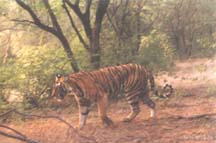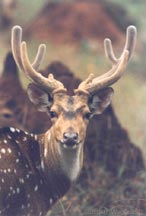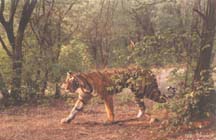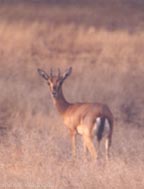 Two Tigers, a pair of Siberian Cranes, a Dusky Horned Owl, and
a Python were the highpoints of our trip to Ranthambhor and
Bharatpur.
Two Tigers, a pair of Siberian Cranes, a Dusky Horned Owl, and
a Python were the highpoints of our trip to Ranthambhor and
Bharatpur.
 Two Tigers, a pair of Siberian Cranes, a Dusky Horned Owl, and
a Python were the highpoints of our trip to Ranthambhor and
Bharatpur.
Two Tigers, a pair of Siberian Cranes, a Dusky Horned Owl, and
a Python were the highpoints of our trip to Ranthambhor and
Bharatpur.
Ranthambhor National Park covers an area of about 275 sq.km and is situated in the Sawai Madhopur district of Eastern Rajasthan. It forms the core area of the Ranthambhor Tiger Reserve. The park is named after the ancient Rajput fort of Ranthambhor situated on top of a hill inside the reserve.
The Ranthambhor Tiger Reserve is one of the best Tiger Reserves in the country. Because of the protection afforded to the wildlife over the last two decades or so, the animals in the park carry on their natural activities without being unduly afraid of or disturbed by human presence. The probability of sighting the tiger in the park is very high.
 The park is opened to the visitors for three hours in the
morning after sunrise and three hours in the evening before
sunset. Moving on foot is prohibited and visitors have to go
around in jeeps. The number of vehicles allowed inside and the
routes on which they can move is also restricted. The animals
have got accustomed to these vehicles and do not fear them or
flee away from them.
The park is opened to the visitors for three hours in the
morning after sunrise and three hours in the evening before
sunset. Moving on foot is prohibited and visitors have to go
around in jeeps. The number of vehicles allowed inside and the
routes on which they can move is also restricted. The animals
have got accustomed to these vehicles and do not fear them or
flee away from them.
There are no tourist facilities inside the Park. Typically, tourists stay in Sawai Madhopur (about 15 km from the Park) and commute to the Park. The Deputy Field Director of the Ranthambhor Tiger Reserve was kind enough to accomodate us in the Forest chowki at Bodal on the Southern outskirts of the National Park. The local village dhaabaa provided simple meals and tea. We spent three days at Ranthambhor.
The second day of our stay was the most exciting. On the ride in the morning session, we sighted a Tiger in the Kuta Banda area. It was about 300 m away from the road and moving up the hill. We could watch it clearly for nearly 2-3 minutes. Our group was overjoyed as, except for me, it was the first time ever that they had seen a tiger in the wild!
 The afternoon session was even better. We met a tigress right
on the road towards Bakola. We watched her as she approached us
and moved past our jeep, totally unconcerned and indifferent to
our presence. We watched her move down the road for nearly 10
minutes till she moved into the bushes. It's impossible to
describe in words the majestic sight and the joy it gave us. It
can only be seen and experienced!
The afternoon session was even better. We met a tigress right
on the road towards Bakola. We watched her as she approached us
and moved past our jeep, totally unconcerned and indifferent to
our presence. We watched her move down the road for nearly 10
minutes till she moved into the bushes. It's impossible to
describe in words the majestic sight and the joy it gave us. It
can only be seen and experienced!
The morning of the third day was spent birdwatching on the Mansarovar - a huge reservoir, about 2 km from Bodal, built primarily for irrigation. Kerkar and I had a good long swim in the lake while the others went in for a boat ride. The afternoon was spent on the Ranthambhor fort. The Ranthambhor fort, believed to have been built in 944 AD by a Chauhan Ruler was of great strategic importance in the days of yore and has seen many battles. The remains give a fair idea of the past grandeur of the fort.
 During the evening ride inside the park, we saw a dead wild
boar lying on the road which must have been killed by a tiger
not too long ago. Apparently, it had abandoned the kill and
gone inside the forest as two tourist vehicles approached the
area. We waited in vain for quite some time hoping that the
tiger would reappear. Further down the route, we heard Sambar
alarm calls from inside the forest indicating the presence of
the tiger. Here again, inspite of waiting for nearly half an
hour, the tiger did not come out of its hiding.
During the evening ride inside the park, we saw a dead wild
boar lying on the road which must have been killed by a tiger
not too long ago. Apparently, it had abandoned the kill and
gone inside the forest as two tourist vehicles approached the
area. We waited in vain for quite some time hoping that the
tiger would reappear. Further down the route, we heard Sambar
alarm calls from inside the forest indicating the presence of
the tiger. Here again, inspite of waiting for nearly half an
hour, the tiger did not come out of its hiding.
The other mammals sighted in the park were : Sambar, Chital, Nilgai, Chinkara, Jackal, Hare, Wild Boar, Langur. We also saw a Crocodile in the Padam Talao.
Next morning we packed up and left for Bharatpur. The Keoladeo National Park was developed by the Maharaja of Bharatpur sometime in the early 1700s as a game reserve. A Roll of Honour (?) lists the names of Desi and Angrezi bahaadurs (??), starting with Lord Curzon, who shot as many as 4500 birds in a day! Sometime in the 1950s the Government of India declared the reserve a bird sanctuary and shooting of game was prohibited. We spent two days birdwatching in the Keoladeo National Park.
 The
Siberian Crane
which is nearing extinction is one of the major attractions of the Keoladeo
National Park. Ten years ago, when I last visited the Park, I had seen about
a dozen pairs. Last year only one pair with a young one had visited Bharatpur
and this year just one pair has arrived so far. Next year ???
The
Siberian Crane
which is nearing extinction is one of the major attractions of the Keoladeo
National Park. Ten years ago, when I last visited the Park, I had seen about
a dozen pairs. Last year only one pair with a young one had visited Bharatpur
and this year just one pair has arrived so far. Next year ???
Other migratory birds have also been late in coming. One reason could be the prolonged monsoons. The water levels were quite high and we could see very few waders.
We spent two days inside the Park covering nearly 20 km on foot each day. Besides the Siberian Cranes, other notable sightings were a Dusky Horned Owl and a Python.
[B => Bharatpur, M => Mansarovar, R => Ranthambhor ]
Mammals Sighted
Birds Identified
Some Logistics
Sawai Madhopur on the Mumbai-New Delhi trunk line is the nearest rail head for going to Ranthambhor. The park is about 15 km from the station. Hotel accomodation to suit different budgets is available in the Sawai Madhopur town. Jeeps charge about Rs.600/- per ride inside the park and carry 4-5 passengers. The other option is to use the Canter service which charges Rs.80/- per passenger.
Bharatpur is also on the Mumbai-New Delhi trunk line. The Keoladeo National Park is about 5 km from the railway station. Many hotels have sprung up and the charges are upwards of Rs.200/- per day per double-bed room. Local dhaabaas provide good meals at a reasonable price. One can also stay inside the park in the Forest Lodge which charges Rs.600/- per day for a double-bed room.